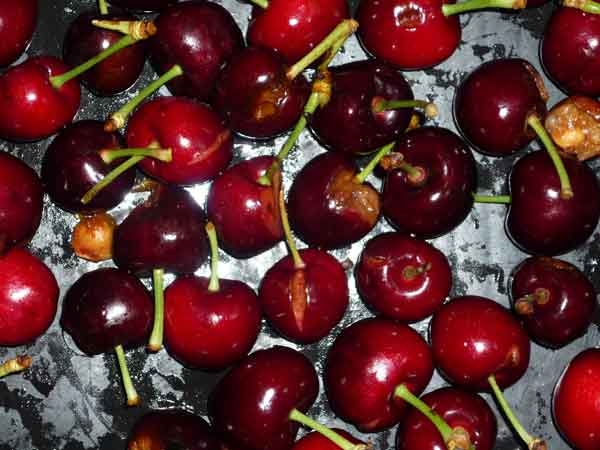Cracking of sweet cherry fruit is a complex phenomenon.
After years of research and practical experimentation we are still looking for that elusive answer to: What do we do about cracking?
We know there is no single or simple answer. Why? Because the mechanisms of cherry cracking are multiple, and still more is being discovered.
Water a critical component
Water is at the heart of the matter. Water is a critical component of good fruit quality, but in excess can lead to poor fruit quality and serious cracking damage.
So let’s look at what we do know about water and its relationship to cracking. We know that water can enter the fruit two ways: from the fruit surface and from within the tree.
Fruit surface
Water on the skin throughout fruit development is associated with microcracks—cracks on the skin that are not visible to the naked eye, but which increase skin permeability to water.
After rainfall, water can sit on the surface of the fruit for long periods, collecting for even longer in the stem bowl, or hanging from the apical end of the fruit (typically resulting in stem-end or apical-end cracks).
The longer the fruit stay wet, the more cracking is likely.
Effective strategies
Strategies that have proven effective for this type of cracking include increasing air flow (such as using helicopters) or the use of various coatings (see Figure 1).
Crop load, or rather crop distribution, may also affect how long fruit stays wet. Fruit clusters where fruit are constantly in contact, will hold water. So consider this in training systems or in pruning management.
Canopy cover—having nice big leaves to protect the fruit underneath—also might help.
Within the tree
Water moves around the inside of the tree.
Water travels through the vascular system (from the roots via the xylem, and from the leaves via the phloem) but how much ends up in the fruit and when, is difficult to quantify in the field.
Flow to the fruit is influenced by the fruit's changing demand for water (water potential). On a sunny day, the greatest demand for water generally occurs mid-afternoon. Before that, the leaves demand more water.
Water distribution throughout the tree plays a role here, so the more fruit there is on the tree, the more water can be ‘shared’. Higher crop loads tend to suffer less from cracking.
Effects of transpiration
Water movement patterns can change on rainy or overcast days.
If leaves are not transpiring, then fruit will take up more of the internal water.
Reduced transpiration on rainy days (in this case movement of water out of the fruit) results in increased flow of water from within the tree to the fruit (but it’s not known whether this is from the phloem, or the xylem, or both).
Encouraging air flow may have an impact by drying leaves and allowing transpiration.
Theoretical water balance model
Both sources and pathways for water movement into the fruit can be in play at the same time. Water can move across gradients into the fruit from within the tree or from the fruit surface.
A paper presented at the last international symposium presented a theoretical water balance model that attempted to combine the pathways.
The study explored the various gradients for water movement recorded in published papers, and applied a model to explain how and when water would move, and what influenced those gradients.
This is a model and hasn’t been tested. It uses information from studies for different varieties from different climates, and includes field and laboratory work.
Transpiration is the key (continues next issue)
See this article in Tree Fruit June 2017




















